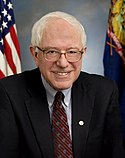Vermont United States Senate election, 2006
|
|
|||||||||||||||||
|---|---|---|---|---|---|---|---|---|---|---|---|---|---|---|---|---|---|
|
|||||||||||||||||
|
|||||||||||||||||

Results by county
Sanders
50-59%
60-69%
70-79%
|
|||||||||||||||||
|
|||||||||||||||||
Sanders
The 2006 United States Senate election in Vermont was held on November 7, 2006. Incumbent independent Senator Jim Jeffords decided to retire rather than seek re-election to a fourth term in office and Bernie Sanders was elected to succeed him.
Sanders represented Vermont's at-large House district as an independent, won the Democratic primary and then dropped out to run as an independent. Many Democratic politicians across the country endorsed Sanders, and no Democrat was on the ballot. The state committee of the Vermont Democratic Party voted unanimously to endorse Sanders.
Sanders won the open seat with 65% of the vote.
Four candidates ran in the primary:
Sanders won the Democratic primary, but declined the nomination, leaving no Democratic nominee on the ballot. This victory ensured that no Democrat would appear on the general election ballot to split the vote with Sanders, an ally of the Democrats, who has been supported by leaders in the Democratic Party.
Tarrant won.
In mid-August 2006, the campaign heated up considerably, with Tarrant fully engaged in heavy media advertising, most of which criticized Sanders' public stances. Tarrant ran several ads accusing Sanders of representing himself differently from his voting record in the House of Representatives, citing such examples as Sanders' votes against Amber Alert and against increased penalties for child pornography. Sanders responded with an ad stating that Tarrant's claims are "dishonest" and "distort my record" and presented what he viewed as more accurate explanations of his voting record.
...
Wikipedia


